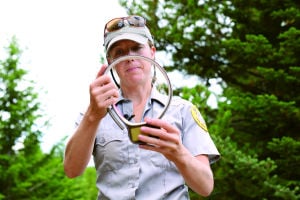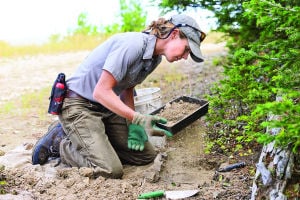FWP wolf management specialist details collaring process
It's a warm morning in the hills southwest of Livingston.
I'm traveling along a ranch road with Montana Fish, Wildlife & Parks
wolf management specialist Abby Nelson. She's ahead of me on an ATV as
we rumble over a cattle guard overlooking a creek bed. The fading aspens
on the hillside foretell autumn.
Nelson is one of six FWP wolf management specialists. She oversees a broad swath of Montana — everything east of Bozeman to the Dakota line, north to the Musselshell River and south to Yellowstone National Park and Wyoming. She's been working with wolves for nine years and looks the part — clad in well-worn Red Ant Pants, dusty boots and work gloves.
Nelson is one of six FWP wolf management specialists. She oversees a broad swath of Montana — everything east of Bozeman to the Dakota line, north to the Musselshell River and south to Yellowstone National Park and Wyoming. She's been working with wolves for nine years and looks the part — clad in well-worn Red Ant Pants, dusty boots and work gloves.
Today, we are on a
ranch in Park County, where Nelson is setting a trap line in hopes of
collaring a wolf from a pack that roams the area. Nelson first
discovered the pack three summers ago. The white-coated alpha male she
observed that first year still holds sway over the other pack members.
“Last year I did not
have a collar on this pack, so a lot of the tracking I had to do the
old-fashioned way,” Nelson said. “In the winter it's skis and
snowmobiles, and during the summer it is all means — 4-wheeler, hiking,
horseback. Wolves cover a lot of country, so it takes a lot of time to
keep up with them without the technology of a radio collar.”
Each of FWP's six
wolf management specialists is charged with three main field tasks. The
first is population monitoring — establishing the counts the state uses
to manage wolves. The second is managing conflicts with livestock by
working with other agencies, landowners and ranchers to address threats
and depredation. The final field task is to deploy radio collars.
Trapping and
helicopter darting are the most common means of collar deployment in the
Paradise Valley. Nelson's trap line today consists of a series of traps
spread over 5 miles of terrain. Nelson anchors each trap to the ground
with a stake, then meticulously masks the trap with soil, leaves and
twigs from the immediate area. Finally, Nelson baits each trap, today's
getting a dose of putrid-smelling wolf gland and urine.
“Wolves are smart,”
Nelson said. “They know we've been here, so usually it is a matter of
making your (trap's) scent more compelling than the human scent that is
around.”
The average
territory of a wolf in Montana spans 220 square miles. Nelson said that
means it can be a week or two before a wolf will pass through an area.
She'll be up to check her traps before 8:30 every morning until the
wolves pass back through.
In the event one of the traps is successful, Nelson will go to work fitting the animal with a radio collar.
“When you approach a
wolf in a trap, they are typically submissive,” Nelson said. “The first
thing is to get drug in it as quickly as possible to minimize stress on
the animal.”
Nelson said wolves
each have a distinct personality. Some are really bold and aggressive;
others aren't so bright; and some a really shy and suspicious. Depending
on the situation and the wolf, Nelson will use either a noose pole and
syringe or a dart pistol to subdue the animal.
Once the wolf is
asleep, Nelson will fit it with a collar and take a blood sample for
disease surveillance and genetic testing. Next she'll measure and weigh
the wolf and determine what sex the animal is. If it is a female, Nelson
will try to determine is the animal is pregnant, has recently bred or
if it is lactating.
The drug's effects generally wear off after about 45 minutes. Nelson said rubber padding on the traps leaves the wolf unharmed.
“Sometimes I will
pull a trap off their foot and you can't even tell which foot it is
(that was caught),” Nelson said. “Other times there will be a little
indentation because the springs are strong and the traps hold tight. All
of the wolves I trap I check up on the day after and I haven't seen any
limping, so I think that is a good sign.”
After waking from
the drug, the wolf will rejoin its pack. Nelson can then monitor the
movements of the wolf and record data on its territory. Nelson will also
observe the wolf monthly from the air to get a bird's eye view of its
movements and count the number of wolves in its pack.
Nelson said
collaring is FWP's best tool to manage livestock conflicts and get
population counts. At the end of each year FWP comes up with a statewide
number to compare to the previous year's population.
“That directs our
harvest approach, so I am really dedicated to getting good on-the-ground
information,” Nelson said. “I think it is really important to have
strong data so that as we go forward introducing new management tools
like hunting and trapping, we have a good sense of where the population
is at and how it is responding to those tools.”
At the end of 2012,
at least 625 wolves roamed the Montana landscape. FWP Region 3
spokeswoman Andrea Jones said the department hopes to see the wolf
population stabilize or decline this hunting season.
“We are well above
where we need to be by our standards,” Jones said. “We did see 4 percent
decrease in wolf population from 2011 year-end to 2012 year-end, but
the prior year we had seen a 15 percent increase despite our harvest
attempts. We are learning and hunters and trappers are learning, but we
still want to see a leveling off. The balance with other species is
still unstable in some areas.”
An additional
benefit of collaring is determining how wolves die. When a collared wolf
stops moving for a given period of time, a signal is dispatched.
“That mortality
information — cause of death, where they die, how they die — is really
essential to managing the population. It is one of the most key metrics
that we use to understand how the population is doing, where it is
headed and the impacts of various mortality factors on the population.”
Jones said the department's efforts are yielding results.
“Part of our wolf
plan is recognizing that they are a native species,” Jones said. “It is
working them in among the livestock producers and the wildlife
enthusiast and watchers.
“We understand that
there are various and very interested parties surrounding the wolf
issue, and we want them to understand we are working for the best
balance possible.”
source
source





No comments:
Post a Comment